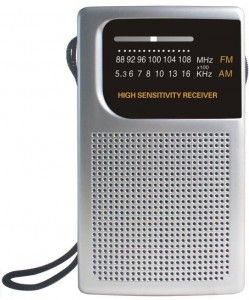In modern society, radio is the most widely used medium of broadcasting and electronic communication: it plays a major role in many areas such as public safety, industrial manufacturing, processing, agriculture, transportation, entertainment, national defense, space travel, overseas communication, news reporting, and weather forecasting.
In radio broadcasts, they use radio waves which can be both microwaves and longer radio waves. These are transmitted in two ways: amplitude modulation (AM ) and frequency modulation ( FM ). These two kinds of waves have many differences.
Radio waves are among the many types of electromagnetic waves that travel within the electromagnetic spectrum. Radio waves can be defined by their frequency (in hertz, after Heinich Hertz , who first produced radio waves electronically), which is the number of times they pass through a complete cycle per second; or by their wavelength, which is determined by the distance (by meters) that is traveled from the crest of one wave to the crest of the next.
Radio frequencies are measured in units called kilohertz, megahertz, and gigahertz. (1 kilohertz = 1000 hertz : 1 megahertz = 1×10^6 hertz, 1 gigahertz = 1×10^9 hertz). All radio waves fall within a frequency range of 3 kilohertz, or 3000 cycles per second to 30 gigahertz.
Within the range of frequencies, radio waves are further divided into two groups or bands such as very low frequency ( VLF 10-30 kHz ), low frequency (LF 30-300 KHz), medium frequency ( MF 300-3000 KHz), high frequency ( HF 3-30 MHZ) and very high frequency ( VHF 30-300MHZ).
Amplitude modulation is the oldest method of transmitting voice and music through the airwaves is by amplitude modulation. This is accomplished by combining a sound wave from a microphone, tape, record, or CD with a “carrier” radio wave. The result: a wave that transmits voice or programming as its amplitude ( intensity ) increases and decreases. Amplitude modulation is used by station broadcasting in the AM band and by most international short wave stations.
Frequency modulation is another way to convey information, voice, and music on a radio wave is to slightly change, or modulate, the frequency. The main advantage of FM broadcasting is of it is static-free. But the drawback to FM is since the frequency is varied, the station takes up more room on the band. Frequency modulation is, of course, used on the FM band. And it is used for “action band” and ham transmission in the VHF/UHF frequency range.
In amplitude modulation, what is modified is the amplitude of a carrier wave on one specific frequency. The antenna sends out two kinds of Am waves: ground waves and sky waves. Ground waves spread out horizontally from the antenna.
They travel through the air along the earth’s surface. Skywaves spread up into the sky. When they reach the layer of the atmosphere called the ionosphere, they may be reflected back to earth. This reflection enables AM radio waves to be received at great distances from the antenna.
Frequency modulation stations generally reach audiences from 15 to 65 miles ( 24-105km) away. Because the frequency of the carrier wave is modulated, rather than amplitude, background noise is reduced. In FM transmission, the frequency of the carrier wave varies according to the strength of the audio signal or program.
Unlike AM, where the strength of the carrier wave varies, the strength of the carrier wave in FM remains the same, while its frequency varies above or below a central value broadcast. FM transmission has broadcast waves ( 88-108 MHZ) that are shorter than AM broadcast waves (540 – 1600 kHz) and do not go as far.
In AM transmission, the amplitude of the carrier waves varies to match changes in the electromagnetic waves coming from the radio studio. In FM transmission, the amplitude of the carrier waves remains constant. However, the frequency of the waves changes to match the electromagnetic waves sent from the studio.
Two types of radio waves are broadcast by AM transmitters: ground waves, which spread out horizontally from the ground and travel along the earth’s surface, and airwaves, which travel up into the ionosphere, allows AM transmission to travel great distances.
AM radio stations with powerful transmitters can reach listeners as far as 1000 miles ( 1600 km ) away.
FM radio waves also travel horizontally and skyward. However, due to the higher frequency of the carrier waves, the waves that go skyward are not reflected. They pass through the atmosphere and into space. Although AM waves can be received at greater distances than FM waves, FM. waves do have advantages.
They are not affected by static as much as Am waves. Static is caused by electricity in the atmosphere. FM waves also result in a truer reproduction of sound than AM waves.
Furthermore, FM has much better sound than AM because AM has a different frequency and wavelength than FM. AM stations broadcast on frequencies of between 535 and 1605 kilohertz. The FM band extends from 88 to 108 megahertz. So that people can compare two different bands on the radio.


you are the very best